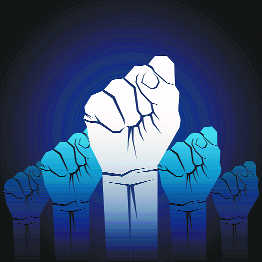Where were you when the Emergency was declared by Indira Gandhi, then Prime Minister, in 1975? The reality is that 50 per cent of this country had not even been born at that time. And the rest of us —unless we were directly in the line of fire, or journalists or politicians or bureaucrats, and thus had to toe the line — were possibly too engrossed in our own little worlds. In fact, there are far too many who till today say “but, at least, the trains ran on time”. For them, it is the discipline that the Emergency imposed that was important.
But those dark days should be constantly part of our political memory and 40 years later, there is a very timely reminder in Coomi Kapoor’s well-researched, balanced, new book The Emergency. Not only does it reconstruct many of the horrific moments, it also chronicles the victims and nameless heroes who had fought for democratic rights and have now been forgotten. Of course, many of those who fought and were jailed also became unforgettable names in the Indian political history, such as Morarji Desai, LK Advani, Arun Jaitley, George Fernandes. Many of those who struggled were also influenced by Jayprakash Narayan, the Gandhian Sarvodaya leader whose name was evoked vociferously during the anti-corruption movement which took place recently under Anna Hazare. But for the Anna Hazare movement, everything was much easier, thanks to the 24/7 TV cameras. The reason why the Congress government between 1975 and 1977 literally got away with murder was because the press had been mostly muzzled and television comprised only Doordarshan, which obviously had to follow the government mandate. And subsequent governments have just not been able to explain why a mother-son duo could be dangerous for democracy!
Reading about how Indira Gandhi and her son Sanjay ran the country on their own whimsical wishes, actually makes one feel unwell. The situation in 1975 and during the last few years of the recent Congress rule had far too many parallels. Should we blame the media for the cover-up of Congress crimes, as so little has emerged about those days in these last 40 years? Is collective amnesia condoning them, because that particular party constantly presents itself as ‘secular’ and pro-poor? And yet we know that its track record is stained with blood, particularly where Punjab is concerned. So why is this propaganda so pervasive?
If one just refers to ‘Five-Point Terror’, a chapter based on Sanjay Gandhi’s highly controversial programme, one realises the extent of human rights violations, harassment of minorities and the marginalised that openly occurred during the Congress rule, in those two terrible years. Ironically, the village of Pipli features in this narrative, where a major riot took place over the forced sterilisation of a widower, who died as incisions turned septic. Much of the state aggression on those helpless was due to Sanjay Gandhi’s insistence on forced sterilisation. Each Block Development Officer had a target to achieve, and that is why, despite the tragic death at Pipli, the situation escalated to such an extent that even though the villagers resisted, the area was surrounded by policemen and village women were shot at. Finally, under threat of aerial bombing (this is so farcical it is astounding), around 500 men were sterilised.
Similarly, in another village in Haryana, Uttawar, the electricity was cut off for weeks to force the population to stop resisting sterilisation programmes. As Coomi points out, “The government felt that to overcome resistance in Uttawar, it would facilitate family planning in the entire Mewat region, which had a high proportion of Muslims.”
A fictitious charge of the possession of firearms was trumped up, and there was the eventual forced sterilisation of over 100 villagers, including a 70 year old.
Within Delhi, some of the worst crimes by the state were committed to fulfil Sanjay Gandhi’s desire to “beautify” certain areas, as well as to sterilise the population. In Turkman Gate, once again a Muslim-dominated area, demolitions of homes were carried out, and at one stage, it was suggested that the bulldozers could be stopped if 300 volunteers could be provided for sterilisation.
Ultimately, the desperate men and women turned to Shahi Imam Abdullah Bhukhari at Jama Masjid, and he encouraged them to protest. This became a full-scale war between unarmed protesters and the police who fired at the stone-throwing crowds. Eight died.
Can we truly forget all these violations? What was done to some of the political prisoners in jail makes for an equally sorry reading. Thus, it is all the more surprising that despite all the documentation, a number of these rights offenders were flying high in the last Congress regime!
Perhaps it is true: those who forget history are condemned to repeat it!
Unlock Exclusive Insights with The Tribune Premium
Take your experience further with Premium access.
Thought-provoking Opinions, Expert Analysis, In-depth Insights and other Member Only Benefits
Already a Member? Sign In Now










